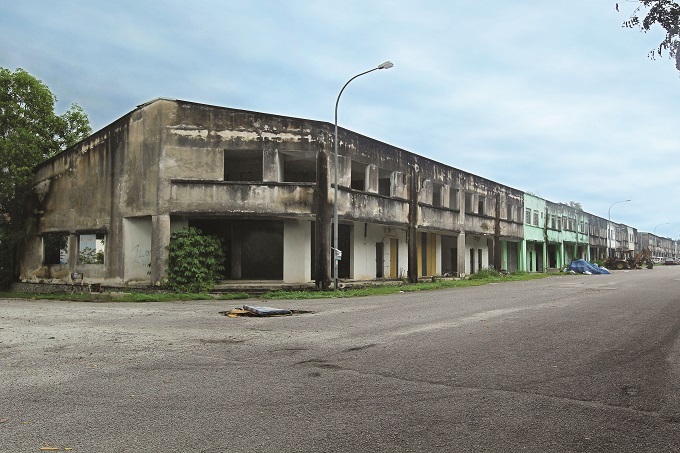
- Instead of minimising abandoned housing projects, the HCGS would potentially be counter-productive, because it would be akin to guaranteeing developers’ profit, even if they run away.
This is the second part of the article on Abandoned housing: Rehda’s solutions missing the forest for the trees.
As mentioned, among the solutions proposed by the Real Estate and Housing Developers’ Association (Rehda) Institute was “a government-led Housing Completion Guarantee System (HCGS) to protect the homebuyers from financial losses and ensure the projects are completed even in cases of developer insolvency”.
However, the first question the Government needs to face is: Why do housing projects get abandoned? The root cause is the lack of and lax in enforcement of existing laws.
The National House Buyers Association (HBA) is deeply concerned that the idea of a Housing Completion Guarantee Corporation (HCGS) should even be mooted at all, because it effectively means the loss from abandonments caused by runaway developers is to be incurred by the government from the coffers aka tax payers’ monies.
Lax in and lack of enforcement
The public who rely on legislation are often let down by the enforcers. Any law is only good on paper and will continue to remain in our archives unless the existing laws or whatever revamped “for the protection of house buyers” are used to their full capacity. Enforcement programmes must be organised and must be implemented.
We have Section 10 of the Housing Development (Control & Licensing) Act 1966, where it is stipulated that the minister may direct the controller or an inspector to, “under condition of secrecy, investigate the commission of any offence under this Act or investigate into the affairs of or into the accounting or other records of any housing developer” if he “has reason to believe” that the housing developer in question is carrying on his business “in a manner detrimental to his purchaser” or “has assets insufficient to meet his liability”.
This Section is further enhanced and amplified with the inclusion of Section 11 (Powers of the minister to give directions for the purpose of safeguarding the interests of purchasers) and Section 10A (Power of entry, search and seizure) and all safeguards and safety nets under the legislation. The minister and his ministry have wide-ranging powers to intervene and salvage a “sick project” and to offer “treatment to provide cure”.
However, just look at the number of abandoned projects that have emerged as a dire financial picture for unwitting and innocent buyers. Individuals and the community are being harmed by the lax enforcement and monitoring mechanism.
Misguided concept: profits privatised—losses nationalised
Currently, the Housing and Local Government Ministry (KPKT) has already taken upon itself to rehabilitate abandoned housing projects, all at taxpayers’ expense.

If it is true that KPKT is seriously considering Rehda Institute’s proposed HCGS, it simply means the government will go up another level in “mopping up” the mess left behind by errant developers. It would clearly be a case where the government were ill advised or, to put it plainly, misled by business groups with vested interests on how to tackle the problems caused by their industry peers without any expenses to themselves.
We hope the government is aware that the road to hell is paved with good intentions. HCGS will not solve the problem of abandoned housing projects. In fact, it will exacerbate it. HCGS will also not solve issues that relate to shoddy workmanship, sub-standard materials, timely delivery and a host of other problems blighting the industry.
The setting up of a HCGS will give developers the “licence” to recklessly launch new housing projects regardless of their viability. This has already happened before, when a top-tier property developer launched over 9,000 housing units simultaneously more than a decade ago, all with shoddy workmanship, and eventually abandoned them. (We will decline to name the developer, because it is still operating, albeit under a rebranded establishment, as there was no action taken against its wrongdoing.) Wouldn’t HCGS be supporting such irresponsible developers? It will be a clear case of “public money—private gains”.
Gambling house buyers’ monies
Housing developers will be encouraged to gamble with house buyers’ monies through the progress billings under the current sell-then-build system (STB), only to abandon the projects at the earliest sign of trouble. This will result in a big increase in cases of abandoned housing projects throughout the country and will pose a huge strain on the HCGS and, ultimately, the government and taxpayers, while the housing developers laugh all the way to the bank. Developers with poor track records or weak financials could be emboldened to start projects without adequate planning or capital.
This ill-conceived HCGS is not the solution to minimise abandoned housing projects. The only way to minimise abandoned housing projects is when developers have to use their own money, and not house buyers’ monies (under the STB system) to complete a housing project. When people use their own money, they will be more careful.
Read also
Abandoned housing: Rehda’s solutions missing the forest for the trees
This ill-conceived HCGS will face all the same problems to revive abandoned housing projects, that is to deal with so many different parties, namely house buyers, end-financiers, bridging financiers, and insurers, all of which have different objectives and interests.
Build-then-sell (BTS) 10:90 concept
Under the BTS 10:90 concept mooted by HBA, the bridging financier can immediately take over an abandoned housing project without having to deal with so many parties and the task of reviving the project will be much easier.
Developers will walk away empty-handed should the project be abandoned as the developers will only have access to house buyers’ funds when the project is successfully completed. Should the project be declared abandoned and the developers had taken a bridging loan to fund construction cost, then the developers’ financiers can take over the project, and it will not involve any public funds.
The BTS 10:90 model is the solution to eradicate or at the least minimise abandoned housing projects, as the developer will suffer the most if a project is abandoned. Hence, the developer will do all it can to ensure the project is completed on time.
Read also
Property Chat: BTS 10:90 is not BTS
Questions to answer before HCGS is considered
Meanwhile, if the government is really mulling over HCGS, here are some questions to consider:
1. The proposed HCGS contradicts the principles of a free-market economy, where risks must be borne by the risk-taker. Shifting that burden to the government violates market discipline. It creates an unfair advantage for developers over other industries that must bear their own risks.
2. Someone would surely have to bear the hefty insurance premium under the HCGS. If the property developer does so, they will surely factor such costs into their sale prices. If the house buyers were to be burdened with payment of premiums, then the benefits from the lower risks accrued will be banks and developers who bear no upfront costs. Is this not another case of hitting innocent purchasers to spare developers?
3. If it is to be government-funded, invariably, a tax payer unable to afford to buy a house is actually funding a house buyer to own a house? Does this make sense to you?
4. The proposal expects taxpayer money to subsidise the risk of private developers, most of which are profit-driven.
5. Who will ensure the interest rates charged for home loans by financial institutions will be reduced for this scheme?
5. House prices have shot through the roof. Why the additional cost to buyers whose affordability is already severely constrained?
6. It will surely weaken buyer confidence in the long term. Buyers may become overly reliant on government “guarantees”, weakening their due diligence when purchasing properties. It gives a false sense of security, especially if the scheme does not fully compensate buyers in the event of abandonment.
7. Why should the government fund the scheme but house buyers still have to bear extra costs?
8. Should the government lead in the proposed HCGS, as suggested by Rehda Institute, because it is deemed to have bottomless pockets? It doesn’t make sense, because the government has just expanded the sale and service tax.
9. Why should the government “underwrite” risks of private business ventures? Why should public funds bail out housing developers, especially when many subsidiary companies have failed, notwithstanding the fact that their parent companies are large corporate entities with healthy balance sheets?
10. The government should prioritise social housing and urban poor needs, not underwrite risks of private ventures.
11. What are the pre-conditions that must be fulfilled before HCGS is activated? Will there be a continuing setback for victims of abandoned housing projects?
12. Is there a need for additional public funds with layers of bureaucracy and headache just to buy a liveable house?
13. Isn’t the proposed HCGS seen for what it really is—an exit door for errant developers? The errant developer will wind up the company and its directors will go scot free by hiding behind the corporate veil, something which happens too rampantly. Then, the HCGS is left to deal with another abandoned project. Isn’t this another form concocted as false protection for house buyers?
14. Is KPKT aware of the news: “Korea Housing Guarantee Receives Massive Bailout”? It was reported in the Chosun media on May 31, 2001 that the government and creditor organisations decided to inject a total of 1.84 trillion won (about RM5.631 billion) into the Korea Housing Guarantee Corp, which has tottered on the brink of insolvency, to put the state-invested housing guarantee firm back on track?
The South Korean model which has been touted by developers as the way to go has to be studied thoroughly. Maybe there are now robust checks and balances in South Korea for the protection of house buyers from unscrupulous developers.
KPKT should engage all stakeholders before making a decision. What is good for South Korea may not be good for our country.
Poor precedent for future policies
This proposal of HCGS was first mooted a decade ago but was rejected by the then government because it was not practical. It was a ludicrous and preposterous suggestion. It has now been remooted with the current Madani government.
If the current government agrees to this, what stops other industries (e.g. automotive, construction, agriculture) from demanding similar insurance subsidies? It opens a floodgate of bad policy demands from other sectors.
The idea of the government absorbing the insurance premium in the Rehda Institute’s proposal raises red flags in terms of public interest accountability and moral hazard.
This article is written by Datuk Chang Kim Loong, honorary secretary-general of the National House Buyers Association (HBA).
HBA is a voluntary non-government and not-for-profit organisation manned wholly by volunteers.
HBA can be contacted at:
Email: [email protected]
Website: www.hba.org.my
Tel: +6012 334 5676
The views expressed are the writers’ and do not necessarily reflect EdgeProp’s.
Does Malaysia have what it takes to become a Blue Zone, marked by health and longevity? Download a copy of EdgeProp’s Blueprint for Wellness to check out townships that are paving the path towards that.





